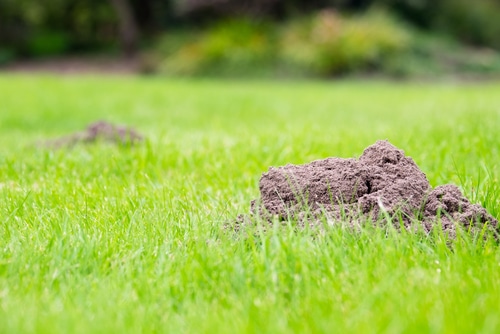Dealing with moles in your yard can be challenging, but a structured approach can help you manage and potentially eliminate them effectively. Here’s a decision tree to guide you through the process:
Getting Rid of Moles, Step By Step
Step 1: Identify Mole Activity
- Question: Have you noticed signs of mole activity, such as mounds of dirt and raised ridges in your yard?
- Yes: Proceed to Step 2.
- No: Continue to monitor your yard for signs of mole activity.
Step 2: Understand Mole Behavior
- Action: Learn about mole habits.
- Key Points:
- Diet: Mainly earthworms and other small soil invertebrates.
- Habitat Preferences: Soft, moist soil.
- Activity: Primarily underground and more active during wet seasons.
- Key Points:
Step 3: Remove Food Sources
- Action: Make your yard less attractive to moles by controlling their food source.
- Methods:
- Biological Control: Introduce beneficial nematodes or milky spore to reduce grub populations.
- Lawn Care: Maintain a healthy lawn to discourage excessive insect activity.
- Methods:
Step 4: Use Repellents
- Question: Do you prefer to use repellents?
- Yes: Choose between natural and chemical repellents.
- Natural Repellents:
- Castor Oil: Apply a mixture of castor oil and water to affected areas.
- Plant-Based: Some plants, like marigolds or daffodils, may deter moles.
- Chemical Repellents: Use commercially available mole repellents following manufacturer’s instructions.
- Natural Repellents:
- No: Consider physical removal methods.
- Yes: Choose between natural and chemical repellents.
Step 5: Physical Removal Methods
- Question: Are you comfortable using traps or other physical methods?
- Yes: Select a humane trapping method.
- Types of Traps:
- Scissor Traps: Placed in active mole tunnels.
- Spear Traps: Positioned over active tunnels.
- Types of Traps:
- No: Seek professional pest control help.
- Yes: Select a humane trapping method.
Step 6: Create Physical Barriers
- Action: Install barriers to prevent moles from entering certain areas.
- Method:
- Underground Fencing: Bury a metal or hardware cloth fence at least 2 feet deep and curve it outward at the bottom.
- Method:
Step 7: Monitor and Adapt
- Routine Actions:
- Regular Inspections: Check for new mole activity regularly.
- Adjust Strategies: If one method isn’t working, try another or combine methods.
Step 8: Professional Assistance
- Question: Is the problem persistent or widespread?
- Yes: Consider hiring a professional wildlife removal service.
- No: Continue with current strategies and monitor results.
Additional Tips
- Regularly flatten molehills and reseed as necessary to maintain lawn appearance.
- Water repellents into the soil after application to ensure they penetrate deeply where moles travel.
Know Your Enemy: Identifying Moles
Before declaring war on these subterranean creatures, it’s crucial to know who you’re up against.
Mole Species Overview
There are several species of moles worldwide, but in North America, your likely culprits include:
- Eastern Mole (Scalopus aquaticus): Your common garden variety with a penchant for lawns and flowerbeds.
- Star-Nosed Mole (Condylura cristata): With its unique star-shaped nose, this one enjoys wetter areas and is a bit of a swimming pro.
- Hairy-Tailed Mole (Parascalops breweri): Look out for its distinctive hairy tail; it’s quite the digger.
Each species has its favorite habitat and diet, which can influence the type and extent of the damage they cause.
Recognizing Mole Damage
In your quest for a pristine yard, watch for these telltale signs of mole activity:
- Volcano-like Mounds (Molehills): These are the dirt piles that moles push to the surface while constructing their tunnels.
- Raised Ridges: Indicators of active runways, these can crisscross your yard and wreak havoc on your grass roots.
Knowledge is power, so by identifying the mole and its damage, you’ll be better equipped to tailor your mole-banishing strategies.
Mole Patrol: Prevention Strategies
Before digging into the tactics, remember preventing moles starts with knowledge of their behavior and your yard’s specific conditions.
Landscape Management for Mole Control
- Stomp it Out: Regularly flatten molehills and compact the soil. This frustrates moles and makes tunneling less appealing.
- Feed the Lawn, Starve the Mole: Apply treatments that reduce mole food sources like grubs and worms. Less food means your yard is a less attractive cafeteria for these critters.
Pointers for a mole-unfriendly lawn include:
- Water Wisely: Over-watering your garden can invite moles by bringing their snacks—earthworms and insects—to the surface.
- Prune with Purpose: Eliminate dense vegetation that moles might use for cover.
Natural Repellents and Deterrents
- Castor Oil Concoctions: Mix castor oil with dish soap and water to create a natural mole repellent. Spray this mixture on your lawn to disrupt moles’ digging.
DIY Deterrents:
- Plant marigolds or daffodils, which are natural mole deterrents.
- Scatter human hair or pet fur around mole-prone areas as a natural scare tactic.
To repel moles:
- Noise Notes: Insert ultrasonic spikes or wind-powered pinwheels. The noise and vibrations can deter moles from settling in your green oasis.
- Scents that Send Moles Packing: Garlic and castor beans are known for their mole-repelling aroma.
The Trap Chronicles: Effective Mole Capture Methods
Embark on a mole-free lawn adventure with hands-on trap tactics that really work. Find out which trap outsmarts these subterranean acrobats and how to position your traps with precision.
Choosing the Right Trap
You’ve got choices when it comes to mole traps, and picking the right one is crucial. Consider these trap styles:
- Scissor Traps: With sharp edges, these spring into action when a mole pushes on the trigger.
- Spear Traps: Insert these over a mole tunnel, and the spring-loaded tines will do the job when triggered.
- Choker Loop Traps: These close a loop around the invading mole when it interacts with the trigger.
Be sure to select a trap based on the soil type and tunnel layout in your yard. Check out UMN Extension for a deep dive on scissor trap deployment techniques.
Trap Placement Techniques
Now, for the art of trap placement. Follow these guidelines to elevate your trapping success rates:
- Locate Active Tunnels: Press down on the tunnels and mark the spots. Revisit in 24-48 hours. Active tunnels will be repaired.
- Set the Trap: Position your trap over these repaired tunnels, ensuring a snug fit on the ground.
- Disguise Your Trap: Camouflage is key. Use soil or turfs to cover the trap, keeping it out of the mole’s suspicion radar.
Remember, firm ground provides better trap stability—avoid soft soil that won’t support your trap effectively. For additional placement strategies, Bob Vila’s step-by-step guide could be your golden ticket.
Chemical Warfare: Using Mole Baits Responsibly
Moles can turn your pristine lawn into unsightly tunnels. Here you’ll learn to wield mole baits effectively and ethically, keeping the environment and safety in mind.
Types of Mole Baits
- Grub-formulated Baits: Mimic the mole’s natural prey. Typically contain the active ingredient Bromethalin.
- Worm-like Baits: Designed to simulate earthworms, a mole’s favorite meal. Often crafted with Warfarin or Bromethalin as active chemicals.
Remember, these baits are toxic and should only be used according to manufacturer guidelines to protect non-targeted wildlife and pets.
Application Tips for Maximum Effectiveness
- Locate Active Tunnels: Press down on the tunnel; if it’s repaired the next day, it’s active. Place baits here for optimal impact.
- Safety First: Always wear gloves when handling baits to prevent skin contact with harmful chemicals.
- Proper Placement: Use a probe to insert baits deeply into tunnels without collapsing them.
- Avoid Detection: Moles are wary creatures. Conceal your intervention by resealing the tunnel entrance with soil or a natural object.
Hiring the Pros: When to Call in Expert Help
When you’ve tried every trick in the book to banish moles from your yard without success, it’s time to consider bringing in the professionals. Knowing when and how to seek expert help can make all the difference in finally achieving a mole-free lawn.
Evaluating Professional Mole Removal Services
- Research the Company: Not all services are created equal. Look for companies with proven expertise in mole removal, such as Orkin or Terminix, and check their track record for success.
- Check Their Methods: Ensure the company uses humane and environmentally friendly methods. Your yard isn’t just a home to moles; it’s part of an ecosystem.
Key Considerations for Hiring:
- The company should have a license and insurance to protect your property and their workers.
- They should offer a guarantee for their services.
The Costs
- Initial Fee: Some companies may charge an assessment fee to diagnose your mole problem.
- Service Packages: Expect to encounter either a flat rate or a per-mole fee for removal services.
- Maintenance Plans: Consider ongoing prevention plans to keep moles at bay after initial removal.
Average Price Ranges:
- Initial visit: Expect to pay between $90 and $150.
- Subsequent removals can range from $50 to $300 per mole, depending on infestation severity and property size.
Frequently Asked Questions
In addressing your curiosity around mole issues, these FAQs are a roundup of tried-and-true solutions and savvy strategies to tackle both the pesky critters in your yard and unwanted moles on your skin.
What are the most effective methods for removing facial moles?
If you’re looking to remove a facial mole, it’s best to consult with a dermatologist. On the medical front, techniques like surgical excision and laser removal are considered highly effective. Remember to always seek professional advice before opting for any mole removal procedure.
What are some quick solutions to eliminate moles in the yard?
Quick fixes to drive moles away from your yard include using repellents and setting traps. Products with castor oil can deter moles from your property. Trapping, when done correctly, can also offer a swift resolution to your mole problem.
What are the best strategies for permanent mole removal?
Permanent mole removal strategies typically require professional intervention. Options include traditional surgical methods and innovative treatments like cryotherapy and radiofrequency ablation. Again, for safety and efficacy, solicit guidance from a medical professional.
Are there any effective natural remedies to remove moles?
While results can vary, natural remedies such as the application of castor oil mixed with baking soda have been touted for their ability to diminish moles if used consistently over time. However, their effectiveness is not guaranteed, and professional evaluation is recommended.
How can one get rid of moles inside the home?
If moles have made their way inside, your action plan should be to:
- Locate and seal entry points to prevent further incursions.
- Set up live traps and check them frequently to avoid unnecessary suffering of the animals.
What techniques do farmers employ to control mole populations?
Farmers often use more extensive control measures such as creating physical barriers, using large-scale traps, and introducing natural predators into the environment.
They may also treat their land to reduce food sources like grubs, which moles feed on.
Last update on 2025-06-06 / Affiliate links / Images from Amazon Product Advertising API





